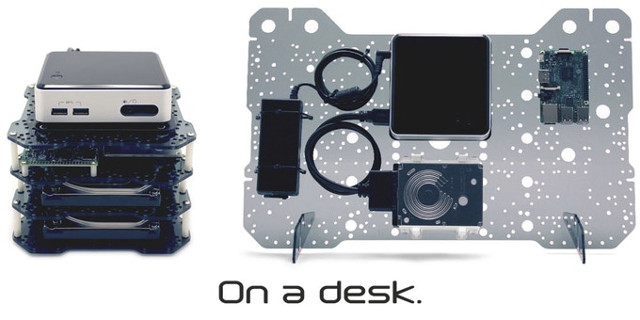If you’ve ever created a quick prototype for your own use, or for your company, you may have based it on a development board, and added some extra modules or add-on modules, as well as potentially accessories such as hard drives or power supply. Software is complete and it works, but it may look like a mess, and transporting it may cause cables to disconnect or other problems.
STEGO BOARD should help in this case. It’s some kind of mounting systems compatible with the most common boards like Raspberry Pi 3, Rock64, or ASUS Tinkerboard, mini-ITX motherboards, mini PCs with VESA mounts, 2.5″ and 3.5″ drives, and so on. So you can create prototypes like the ones below.
 Six different products are available:
Six different products are available:
- STEGO BOARD 102 – 2 layers of the smaller board with 106 parts (stands, screws, zip ties). Can be used with mini PC, development board, up to 2 SATA drives
- STEGO BOARD 103 – 3 layers of the smaller board with 144 parts. Up to 3 SATA drives
- STEGO BOARD 104 – 4 layers of the smaller board with 206 parts. Up to 4 SATA drives
- STEGO BOARD 105 – 5 layers of the smaller board with 246 parts. Up to 5 SATA drives
- STEGO BOARD 400 – Larger board with 220 parts can be be used for up to 4 SATA drives, mini ITX motherboard, graphics card, etc…
- STEGO BOARD 400+ – BOARD 400 and 102 together
They also have 3D printers accessories to create prisms and cubes with the STEGO BOARDs, as well as hard drive caddies, power supply brackets, and cable guard. The developers also released a Windows based simulator to create a virtual prototype.
The STEGO BOARD has been launched on Kickstarter and almost reached its $8,850 CAD target. A $39 CAD pledge (~$31 US) should get you a STEGO BOARD 102 kit, while at the other end of the scale, STEGO BOARD 400+ requires a $105 CAD pledge (~$84 US). Shipping adds $17 CAD to $56 CAD, and sadly the company has decided to limit shipping to USA, Canada, and the United Kingdom only. Delivery is planned for December 2017. The 3D printed accessories are available on a separate website.

Jean-Luc started CNX Software in 2010 as a part-time endeavor, before quitting his job as a software engineering manager, and starting to write daily news, and reviews full time later in 2011.
Support CNX Software! Donate via cryptocurrencies, become a Patron on Patreon, or purchase goods on Amazon or Aliexpress






Nice idea :), but seems expensive for plastic, bolts & so forth :(.